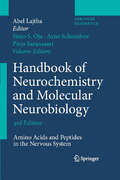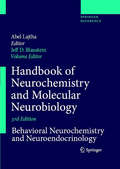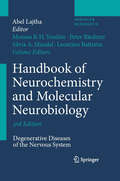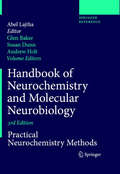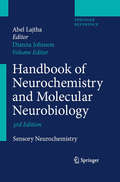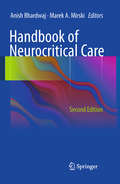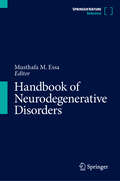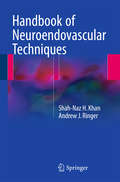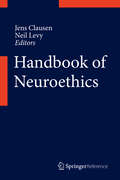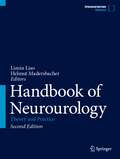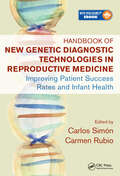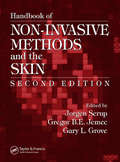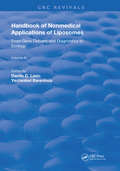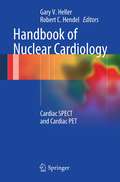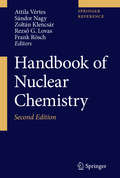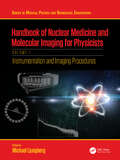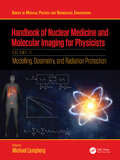- Table View
- List View
Handbook of Neurochemistry and Molecular Neurobiology: Amino Acids and Peptides in the Nervous System (Handbook Of Neurochemistry And Molecular Neurobiology Ser.)
by Simo S. Oja Abel Lajtha Pirjo Saransaari Arne SchousboeThe Second Edition of the Handbook of Neurochemistry, which was published about 24 years ago, consisted of 10 volumes. The present, Third Edition, The Handbook of Neurochemistry and Molecular Biology, is over twice as large; indicating a great expansion of neuroscience in the past two decades. We now have not only more data on brain mechanisms relating to behavior (mental activity and cognitive processes), but we understand in some detail the mechanisms of these functions. The past editions focused purely on neurochemical aspects – the new edition reflects the need of interdisciplinary approach for understanding neural mechanisms. In addition to metabolic processes, the 17 new volumes explore the functions of peptides, transport, immunology and other processes not well understood 24 years ago. Several volumes deal with pathological changes and with repair and therapy of both mental and neurological pathologies. The purpose of this edition is to provide an evaluation of the results of investigations; to serve as a guide rather than enumerating all the available findings in detail – it indicates future possibilities and the existing knowledge in neuroscience. The significance of understanding neural processes needs no emphasis – its potential is primary in mental and neural pathology, but also in physiological importance. The volumes should serve as an aid to researchers expanding our knowledge and to educators training the next generation of neuroscientists and clinicians.
Handbook of Neurochemistry and Molecular Neurobiology: Behavioral Neurochemistry, Neuroendocrinology and Molecular Neurobiology (Handbook Of Neurochemistry And Molecular Neurobiology Ser.)
by Abel Lajtha Jeffrey D BlausteinThe Handbook is intended to be a service to the neuroscience community, to help in finding available and useful information, to point out gaps in our knowledge, and to encourage continued studies. It represents the valuable contributions of the many authors of the chapters and the guidance of the editors and most important, it represents support for research in this discipline. Based on the rapid advances in the years since the second edition.
Handbook of Neurochemistry and Molecular Neurobiology: Degenerative Diseases of the Nervous System (Handbook Of Neurochemistry And Molecular Neurobiology Ser.)
by Abel Lajtha Leontino Battistin Moussa B.H. Youdim Peter Riederer Sylvia A. MandelTitle is also available as part of a set: Handbook of Neurochemistry and Molecular Biology (978-0-387-30426-7)
Handbook of Neurochemistry and Molecular Neurobiology: Practical Neurochemistry Methods (Handbook Of Neurochemistry And Molecular Neurobiology Ser.)
by Susan Dunn Abel Lajtha Andrew Holt Glen BakerThe Handbook is intended to be a service to the neuroscience community, to help in finding available and useful information, to point out gaps in our knowledge, and to encourage continued studies. It represents the valuable contributions of the many authors of the chapters and the guidance of the editors and most important, it represents support for research in this discipline. Based on the rapid advances in the years since the second edition
Handbook of Neurochemistry and Molecular Neurobiology: Sensory Neurochemistry (Handbook Of Neurochemistry And Molecular Neurobiology Ser.)
by Abel Lajtha Dianna A. JohnsonTitle is also available as part of a set: Handbook of Neurochemistry and Molecular Biology (978-0-387-30426-7)
Handbook of Neurocritical Care
by Anish Bhardwaj Marek A. MirskiNeurocritical care as a subspecialty has grown rapidly over the last two decades and has reached a level of distinct maturity with the advent of newer monitoring, diagnostic and therapeutic modalities in a variety of brain and spinal cord injury paradigms. Handbook of Neurocritical Care, Second Edition remains true to the operative tenet that "time is brain," and rapid diagnosis and therapeutic interventions in these challenging patients cannot be overemphasized. The second edition of this important Handbook again serves as a quick, practical reference for those involved in the care of critically ill neurological and neurosurgical patients. The care provided to this subset of critically ill patients continues to be multidisciplinary and includes care rendered from colleagues in emergency medical services, emergency medicine, neurology, neurosurgery, anesthesiology, critical care, nursing and physician assistance. Fully updated, all of the chapters again consist of easy-to-read, bulleted points followed by a list of Key Points and important references allowing for rapid access to vital information critical for fast and timely decision making. The first section covers a myriad of important general principles while the second section addresses the major diagnostic categories of neurocritical care with several new topics; these include, for example, neuroleptic malignant syndrome and malignant hyperthermia, meningitis and encephalitis, and intraventricular hemorrhage. Readers will find the algorithms, tables, and illustrations throughout the book not only useful but truly invaluable in facilitating fast and accurate decision making. Accessible and comprehensive, Handbook of Neurocritical Care, Second Edition again fills a vital need by providing readers with a succinct and practical approach to the management of critically ill neurological and neurosurgical patients.
Handbook of Neurodegenerative Disorders
by Musthafa M. EssaThis Handbook discusses the pathology, etiology, pathogenesis, and therapeutic interventions of different neurodegenerative diseases. The initial section of the Handbook reviews the recent advances in understanding neurodegenerative diseases and the commonalities and differences between the major pathologies. The subsequent section presents recent developments in understanding fundamental biological mechanisms that influence the onset and development of neurodegenerative diseases. It provides current biomedical studies that are aimed at identifying the underlying causes of neurodegeneration. The book also examines the recent observations from biological, cellular, and studies from the model organisms for gaining mechanistic insights into neurodegenerative disorders. It also presents the epidemiological and genetics studies relevant to clinical aspects of neurodegenerative diseases. The book's subsequent chapters offer new and more effective therapeutic strategies to combat these devastating diseases. Towards the end, the Handbook presents recent advances in molecular diagnostics for neurodegenerative disorders and a perspective on the future directions to provide a framework for further developments and refinements of molecular diagnostics to combat neurodegenerative diseases.
Handbook of Neuroendovascular Techniques
by Shah-Naz H. Khan Andrew J. RingerThis handbook provides step-by-step instructions enabling even a novice in the field of interventional neuroradiology/endovascular neurosurgery to perform a procedure. It covers the breadth of mainstream endovascular techniques. This manual provides lucid, readily accessible and pertinent hands-on information. It focuses on practicalities such as technique, choice of equipment and rationale, contrast agents, medications, precise pre- and post-procedure management and management of complications. It does not elaborate on theoretical aspects of disease e. g. , etiology, pathogenesis, statistics, etc. In essence, it provides the necessary information to enable performance of a procedure. Handbook of Neuroendovascular Techniques will be a great resource for a whole range of physicians from residents, to those just embarking on their own independent practice to established experts reviewing methodology of a technique. The authors have a depth of experience and are highly qualified, ensuring objective, pertinent, authoritative and competent coverage of subject matter.
Handbook of Neuroethics
by Neil Levy Jens ClausenBased on the study of neuroscientific developments and innovations, examined from different angles, this Handbook provides a comprehensive overview of the international neuroethical debate, and offers unprecedented insights into the impact of neuroscientific research, diagnosis, and therapy. Neuroethics as a multi-disciplinary and inter-disciplinary endeavor examines the implications of the neurosciences for human beings in general and for their self-understanding and their social interactions in particular. The range of approaches adopted in neuroethics and thus in this handbook includes but is not limited to historical, anthropological, ethical, philosophical, theological, sociological and legal approaches. The Handbook deals with a plethora of topics, divided into in three parts: the first part contains discussions of theories of neuroethics and how neuroscience impacts on our understanding of personal identity, free will, and other philosophical concepts. The second part is dedicated to issues involved in current and future clinical applications of neurosciences, such as brain stimulation, brain imaging, prosthetics, addiction, and psychiatric ethics. The final part deals with neuroethics and society and includes chapters on neurolaw, neurotheology, neuromarketing, and enhancement. "
Handbook of Neuroprosthetic Methods
by Warren E. Finn Peter G. LoPrestiWork in the field of neuroprosthetics requires multidisciplinary teams, but these collaborators must meet on common ground to develop an understanding of the capabilities and limitations of each part of a bioengineering project. The Handbook of Neuroprosthetic Methods provides a comprehensive resource for the techniques, methodologies, and options
Handbook of Neurosociology
by Jonathan H. Turner David D. FranksUntil recently, a handbook on neurosociology would have been viewed with skepticism by sociologists, who have long been protective of their disciplinary domain against perceived encroachment by biology. But a number of developments in the last decade or so have made sociologists more receptive to biological factors in sociology and social psychology. Much of this has been encouraged by the coeditors of this volume, David Franks and Jonathan Turner. This new interest has been increased by the explosion of research in neuroscience on brain functioning and brain-environment interaction (via new MRI technologies), with implications for social and psychological functioning. This handbook emphasizes the integration of perspectives within sociology as well as between fields in social neuroscience. For example, Franks represents a social constructionist position following from G.H. Mead's voluntaristic theory of the act while Turner is more social structural and positivistic. Furthermore, this handbook not only contains contributions from sociologists, but leading figures from the psychological perspective of social neuroscience.
Handbook of Neurosurgery, Neurology, and Spinal Medicine for Nurses and Advanced Practice Health Professionals
by Michael Y. Wang Praveen V. Mummaneni Andrea L. Strayer Odette A. Harris Cathy M. RosenbergThis practical handbook allows nurses, advanced practice nurses, physician assistants, and allied health professionals practicing in the fields of neurosurgery, neurology, and spinal care to quickly review essentials while in the work environment. It emphasizes procedural steps and critical elements in patient management, including intensive care, the neurological examination, differential diagnoses, and pain management. Written by a multidisciplinary team of experts, the handbook is expected to become a well-worn companion and essential aid to the busy practitioner.
Handbook of Neurotoxicity
by Richard M. KostrzewaThe Handbook of Neurotoxicity is a reference source for identifying, characterizing, instructing on use, and describing outcomes of neurotoxin treatments to understand mechanisms associated with toxin use; to project outcomes of neurotoxin treatments; to gauge neurotoxins as predictors of events leading to neurodegenerative disorders and as aids to rational use of neurotoxins to model disease entities. Neuroprotection is approached in different manners includingthose 1) afforded by therapeutic agents clinical and preclinical; or 2) by non-drug means, such as exercise. The amorphous term neurotoxin is discussed in terms of the possible eventuality of a neuroprotectant producing an outcome of excess neuronal survival and a behavioral spectrum that might produce a dysfunction akin to a neurotoxin s effect. The Handbook of Neurotoxicity is thus an instructive and valuable guide towards understanding the role of neurotoxins/neurotoxicity in the expansive field of Neuroscience, and is an indispensable tool for laboratory investigators, neuroscientists, and clinical researchers. "
Handbook of Neurotoxicity
by Richard M. KostrzewaThis handbook is a reference source for identifying, characterizing, instructing on use, and describing outcomes of neurotoxin treatments – to understand mechanisms associated with toxin use; to project outcomes of neurotoxin treatments; to gauge neurotoxins as predictors of events leading to neurodegenerative disorders and as aids to rational use of neurotoxins to model disease entities. Neuroprotection is approached in different manners including those 1) afforded by therapeutic agents – clinical and preclinical; or 2) by non-drug means, such as exercise. The amorphous term ‘neurotoxin’ is discussed in terms of the possible eventuality of a neuroprotectant producing an outcome of excess neuronal survival and a behavioral spectrum that might produce a dysfunction – akin to a neurotoxin’s effect. This new edition significantly expands on the information provided in the first edition, providing the latest research in neurotoxicity and highlighting the relationship between specific neurotoxins and the neurodegenerative disorders they can cause. It also includes new sections on the neurotoxicity of heavy metals, fungi, and snake venom. The Handbook of Neurotoxicity is thus an instructive and valuable guide towards understanding the role of neurotoxins/neurotoxicity in the expansive field of Neuroscience, and is an indispensable tool for laboratory investigators, neuroscientists, and clinical researchers.
Handbook of Neurourology: Theory and Practice
by Limin Liao Helmut MadersbacherThis book introduces neurourology as an emerging interdisciplinary area that covers the basic and clinical studies of the neural control on the normal lower urinary tract and the lower/upper urinary tract dysfunction due to neuropathy disorders. It systematically describes all aspects of neurourology from the epidemiology of the neurogenic bladder; to the pathology and pathophysiology of the lower urinary tract; to the diagnosis and treatment of the neurogenic bladder by conservative therapies or surgeries. This book provides a useful resource for medical doctors, nurses and students in the field of neurourological conditions.In this 2nd edition, 15 chapters are added, e.g. on urodynamic practice, psychogenic reasons of LUTDs, standard of care, physiotherapy, upper urinary tract rehabilitation to enable self-catheterization, pediatric neurourology, new surgical procedures. The editors have invited an impressive number of renowned contributors, including 98 internationally recognized specialists in this field from 25 countries in Europe, Asia, North America, and South America. This handbook provides a useful resource for medical doctors, nurses and students in the field of neurourological conditions.
Handbook of New Genetic Diagnostic Technologies in Reproductive Medicine: Improving Patient Success Rates and Infant Health
by Carlos Simón Carmen RubioDifferent genetic diagnostic and treatment options are used worldwide to improve routine IVF procedures for the benefit of patients. This handbook updates the new genetic diagnostic technologies that have been translated to practice aiming to improve outcomes in the clinic and have a healthy baby at home. Chapters cover the use of genetic technologies in a personalized manner to unravel the possible genetic risks for the couple wishing to conceive, in terms of sperm, the embryo, the endometrium, miscarriage, and finally the fetus.
Handbook of Non-Invasive Methods and the Skin
by Gregor B.E. Jemec Gary L. Grove Jorgen SerupWith contributions from prominent experts, this comprehensive handbook covers the field of non-invasive biophysical measurement methods in clinical and experimental dermatology. Structured to provide both educational and practical information, the book has proven to be of value to both young researchers and senior scientists. All coverage of major evaluation and measurement methods share a consistent format, covering scope, sources of error, application, and validity. The second edition incorporates 69 revised chapters and 95 new chapters covering topics such as computer technique, imaging techniques, skin friction, barrier functions, and more.
Handbook of Nonmedical Applications of Liposomes: From Gene Delivery and Diagnosis to Ecology (Routledge Revivals #4)
by Danilo D. Lasic Yechezkel BarenholzFirst published in 1996, liposomes have become an important model in fundamental biomembrane research, including biophysical, biochemical, and cell biological studies of membranes and cell function. They are thoroughly studied in several applications, such as drug delivery systems in medical applications and as controlled release systems, microencapsulating media, signal carriers, support matrices, and solubilizers in other applications. While medical applications have been extensively reviewed in recent literature, there is a need for easily accessible information on applications for liposomes beyond pharmacology and medicine. The Handbook of Nonmedical Applications of Liposomes fills this void.This unique new handbook series presents recent developments in the use of liposomes in many scientific disciplines, from studies on the origin of life, protein function, and vesicle shapes, to applications in cosmetics, diagnostics, ecology, bioreclamation, and the food industry. In these volumes many of the top experts contribute extensive reviews of their work.
Handbook of Nuclear Cardiology
by Gary V. Heller Robert C. HendelThis small handbook provides a "just the facts" approach to the use of nuclear cardiology for the general cardiology population. It is an adjunct to the existing literature in providing a simple case-based approach to the methodology, application and results of the use of nuclear cardiology. It is a fast-access, pocket-sized compendium of information, heavily biased toward a clinical cardiology population. As such it will be a low-priced, colorful and appealing reference resource that will be popular to a large number of cardiologists internationally. As greater numbers of countries invest in the new techniques, the hunger for information will increase vastly.
Handbook of Nuclear Cardiology: Cardiac SPECT and Cardiac PET
by Gary V. Heller Robert C. HendelThis extensively revised edition of this important textbook provides a practical approach to the use of nuclear cardiology for the general cardiologist. It is an adjunct to the existing literature in nuclear cardiology, providing a simple case-based approach to understanding the methodology, application and outcomes of the modality, and representing a pocket-sized compendium designed for a clinical cardiology audience. Nuclear cardiology procedures have been a mainstay in noninvasive testing for the diagnosis and risk stratification of coronary artery disease for many years. Although a mature field with a multitude of clinical applications, the advances in the technology and imaging procedures have been remarkable and important to document.Handbook of Nuclear Cardiology: Cardiac SPECT and Cardiac PET reviews the important indications for choosing nuclear cardiology procedures and provides a description of the procedures themselves, including both SPECT and PET imaging protocols, as well as supplying readers with a the key readings resources. It emphasizes how noninvasive testing results can be used clinically and the appropriateness of such techniques using a concise and logical structure, vital for trainees, practicing physicians, nurses and technologists looking for a brief, up-to-date overview and reference volume for nuclear cardiology. It therefore represents an essential reference for a large number of cardiologists internationally looking for information in the field.
Handbook of Nuclear Chemistry
by Attila Vértes Frank Rösch Sándor Nagy Rezso György Lovas Zoltán KlencsárThis revised and extended 6 volume handbook set is the most comprehensive and voluminous reference work of its kind in the field of nuclear chemistry. The Handbook set covers all of the chemical aspects of nuclear science starting from the physical basics and including such diverse areas as the chemistry of transactinides and exotic atoms as well as radioactive waste management and radiopharmaceutical chemistry relevant to nuclear medicine. The nuclear methods of the investigation of chemical structure also receive ample space and attention. The international team of authors consists of scores of world-renowned experts - nuclear chemists, radiopharmaceutical chemists and physicists - from Europe, USA, and Asia. The Handbook set is an invaluable reference for nuclear scientists, biologists, chemists, physicists, physicians practicing nuclear medicine, graduate students and teachers - virtually all who are involved in the chemical and radiopharmaceutical aspects of nuclear science. The Handbook set also provides further reading via the rich selection of references.
Handbook of Nuclear Medicine and Molecular Imaging for Physicists: Instrumentation and Imaging Procedures, Volume I (Series in Medical Physics and Biomedical Engineering)
by Michael LjungbergThis state-of-the-art handbook, the first in a series that provides medical physicists with a comprehensive overview into the field of nuclear medicine, is dedicated to instrumentation and imaging procedures in nuclear medicine. It provides a thorough treatment on the cutting-edge technologies being used within the field, in addition to touching upon the history of their use, their development, and looking ahead to future prospects. This text will be an invaluable resource for libraries, institutions, and clinical and academic medical physicists searching for a complete account of what defines nuclear medicine. The most comprehensive reference available providing a state-of-the-art overview of the field of nuclear medicine Edited by a leader in the field, with contributions from a team of experienced medical physicists Includes the latest practical research in the field, in addition to explaining fundamental theory and the field's history
Handbook of Nuclear Medicine and Molecular Imaging for Physicists: Modelling, Dosimetry and Radiation Protection, Volume II (ISSN)
by Michael LjungbergMathematical modelling is an important part of nuclear medicine. Therefore, several chapters of this book have been dedicated towards describing this topic. In these chapters, an emphasis has been put on describing the mathematical modelling of the radiation transport of photons and electrons, as well as on the transportation of radiopharmaceuticals between different organs and compartments. It also includes computer models of patient dosimetry. Two chapters of this book are devoted towards introducing the concept of biostatistics and radiobiology. These chapters are followed by chapters detailing dosimetry procedures commonly used in the context of diagnostic imaging, as well as patient-specific dosimetry for radiotherapy treatments. For safety reasons, many of the methods used in nuclear medicine and molecular imaging are tightly regulated. Therefore, this volume also highlights the basic principles for radiation protection. It discusses the process of how guidelines and regulations aimed at minimizing radiation exposure are determined and implemented by international organisations. Finally, this book describes how different dosimetry methods may be utilized depending on the intended target, including whole-body or organ-specific imaging, as well as small-scale to cellular dosimetry.This text will be an invaluable resource for libraries, institutions, and clinical and academic medical physicists searching for a complete account of what defines nuclear medicine. The most comprehensive reference available providing a state-of-the-art overview of the field of nuclear medicine Edited by a leader in the field, with contributions from a team of experienced medical physicists, chemists, engineers, scientists, and clinical medical personnel Includes the latest practical research in the field, in addition to explaining fundamental theory and the field's history
Handbook of Nuclear Medicine and Molecular Imaging for Physicists: Radiopharmaceuticals and Clinical Applications, Volume III (Series in Medical Physics and Biomedical Engineering)
by Michael LjungbergThis state-of-the-art handbook, the third and final in a series that provides medical physicists with a comprehensive overview into the field of nuclear medicine, focuses on highlighting the production and application of radiopharmaceuticals. With this, the book also describes the chemical composition of these compounds, as well as some of the main clinical applications where radiopharmaceuticals may be used. Following an introduction to the field of radiopharmacy, three chapters in this book are dedicated towards in-depth descriptions of common radionuclides and radiopharmaceuticals used during diagnostic studies utilizing planar/Single Photon Emission Computed Tomography (SPECT) imaging, in addition to during Positron Emission Tomography (PET) imaging, and, finally, radiotherapy. These chapters are followed by those describing procedures relating to quality control and manufacturing (good manufacturing practices) also encompassing aspects such as environmental compliance. Furthermore, this volume illustrates how facilities handling these chemicals should be designed to comply with set regulations. Like many pharmaceuticals, the development of radiopharmaceuticals relies heavily on the use of mouse models. Thus, the translation of radiopharmaceuticals (i.e., the process undertaken to assure that the functionality and safety of a newly developed drug is maintained also in a human context), is covered in a later chapter. This is followed by a chapter emphasising the importance of safe waste disposal and how to assure that these procedures meet the requirements set for the disposal of hazardous waste. Several chapters have also been dedicated towards describing various medical procedures utilizing clinical nuclear medicine as a tool for diagnostics and therapeutics. As physicists may be involved in clinical trials, a chapter describing the procedures and regulations associated with these types of studies is included. This is followed by a chapter focusing on patient safety and another on an imaging modality not based on ionizing radiation – ultrasound. Finally, the last chapter of this book discusses future perspectives of the field of nuclear medicine. This text will be an invaluable resource for libraries, institutions, and clinical and academic medical physicists searching for a complete account of what defines nuclear medicine. The most comprehensive reference available providing a state-of-the-art overview of the field of nuclear medicine Edited by a leader in the field, with contributions from a team of experienced medical physicists, chemists, engineers, scientists, and clinical medical personnel Includes the latest practical research in the field, in addition to explaining fundamental theory and the field's history
Handbook of Nuclear, Biological, and Chemical Agent Exposures
by Jerrold B. Leikin Robin B. McFeeTreating nuclear, biological, and chemical agent exposures presents a unique set of challenges. These scenarios usually involve multiple exposures, sometimes even mass exposures, from a single, often poorly-defined, event. Early symptoms are not distinct and can often be variable. Laboratory analyses may be required from environmental, often nonbio
